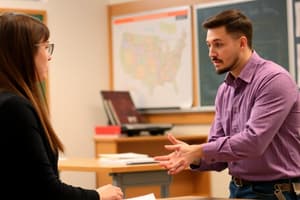Podcast
Questions and Answers
What is academic learning time?
What is academic learning time?
The portion of engaged time where students are actually learning.
What does allocated time mean?
What does allocated time mean?
The amount of time students and teachers spend at school.
Define asynchronous communication.
Define asynchronous communication.
A form of communication that does not involve immediate feedback from each other.
What characterizes an authoritarian teacher?
What characterizes an authoritarian teacher?
How is an authoritative teacher defined?
How is an authoritative teacher defined?
What is classroom management?
What is classroom management?
What is conflict resolution?
What is conflict resolution?
Define congruent communication.
Define congruent communication.
What is emphatic listening?
What is emphatic listening?
What does engaged time or time on task refer to?
What does engaged time or time on task refer to?
What is a functional assessment?
What is a functional assessment?
Define interpersonal collaboration.
Define interpersonal collaboration.
What is a learning center?
What is a learning center?
What does non-verbal communication entail?
What does non-verbal communication entail?
Define paralanguage.
Define paralanguage.
What are participation structures?
What are participation structures?
What is peer mediation?
What is peer mediation?
What are positive behavioral supports?
What are positive behavioral supports?
Define a positive learning environment.
Define a positive learning environment.
What are procedures or routines in classroom management?
What are procedures or routines in classroom management?
What are rules in the context of classroom management?
What are rules in the context of classroom management?
Define self-management.
Define self-management.
What are social skills?
What are social skills?
What does synchronous communication involve?
What does synchronous communication involve?
Flashcards
Academic Learning Time
Academic Learning Time
Time spent on learning activities, actively engaging students in the learning process.
Allocated Time
Allocated Time
The total time allocated for instruction, including both teacher and student time in the classroom.
Engaged Time/Time on Task
Engaged Time/Time on Task
The portion of allocated time where students are actually engaged in learning, focusing on tasks and activities.
Synchronous Communication
Synchronous Communication
Signup and view all the flashcards
Asynchronous Communication
Asynchronous Communication
Signup and view all the flashcards
Congruent Communication
Congruent Communication
Signup and view all the flashcards
Non-Verbal Communication
Non-Verbal Communication
Signup and view all the flashcards
Paralanguage
Paralanguage
Signup and view all the flashcards
Authoritarian Teacher
Authoritarian Teacher
Signup and view all the flashcards
Authoritative Teacher
Authoritative Teacher
Signup and view all the flashcards
Classroom Management
Classroom Management
Signup and view all the flashcards
Participation Structures
Participation Structures
Signup and view all the flashcards
Conflict Resolution
Conflict Resolution
Signup and view all the flashcards
Functional Assessment
Functional Assessment
Signup and view all the flashcards
Peer Mediation
Peer Mediation
Signup and view all the flashcards
Positive Behavioral Supports
Positive Behavioral Supports
Signup and view all the flashcards
Self-Management
Self-Management
Signup and view all the flashcards
Learning Center
Learning Center
Signup and view all the flashcards
Positive Learning Environment
Positive Learning Environment
Signup and view all the flashcards
Emphatic Listening
Emphatic Listening
Signup and view all the flashcards
Social Skills
Social Skills
Signup and view all the flashcards
Procedures/Routines
Procedures/Routines
Signup and view all the flashcards
Rules
Rules
Signup and view all the flashcards
Study Notes
Academic Time Concepts
- Academic learning time: Duration during which students are actively engaged in the learning process.
- Allocated time: Total time dedicated by students and teachers while at school.
- Engaged time/Time on task: Portion of allocated time actively spent by students in learning activities.
Communication Forms
- Asynchronous: Communication method that lacks immediate feedback; responses occur at different times.
- Congruent communication: Consistent messaging across verbal and nonverbal channels, reinforcing the same message.
- Non-verbal communication: Involves gestures, facial expressions, tone, and other non-verbal cues to convey messages.
- Paralanguage: Aspects of spoken language such as volume, pitch, and pronunciation that accompany the actual words.
- Synchronous: Real-time communication involving immediate, two-way exchanges.
Teacher Roles
- Authoritarian teacher: Focuses on strict behavioral control and discipline in the classroom.
- Authoritative teacher: Balances firm direction with acknowledgment of each student's individual contributions.
Classroom Management
- Classroom management: Encompasses all factors affecting the educational environment, both from teachers and students.
- Participation structures: Methods utilized in the classroom, including lecturing, discussions, and group activities.
Behavioral Strategies
- Conflict resolution: Techniques aimed at resolving disagreements peacefully among students.
- Functional assessment: Series of assessments to understand the reasons behind problematic behaviors in students.
- Peer mediation: Involves trained students in facilitating the resolution of conflict among their peers.
- Positive behavioral supports: Techniques designed to encourage appropriate behaviors and address behavioral challenges.
- Self-management: Taking responsibility for one's own actions and well-being.
Learning Environments
- Learning center: Designated areas within a classroom aimed at achieving specific educational goals.
- Positive learning environment: Classroom atmosphere that promotes respect, clear behavioral standards, positive emotions, and collaborative success.
Social Interaction
- Emphatic listening: Actively attempting to connect and understand another person's perspective beyond mere sympathy.
- Social skills: Behavioral patterns that are acceptable in society and foster positive interactions, avoiding negative situations.
Classroom Guidelines
- Procedures/Routines: Established practices that guide classroom activities to ensure smooth operation.
- Rules: Set standards of behavior that students are expected to follow.
Studying That Suits You
Use AI to generate personalized quizzes and flashcards to suit your learning preferences.
Description
Test your knowledge on key educational concepts such as academic time, communication forms, and the various roles of teachers. This quiz covers aspects of engaged learning, communication methods, and teaching styles. Perfect for educators and students interested in pedagogy.




